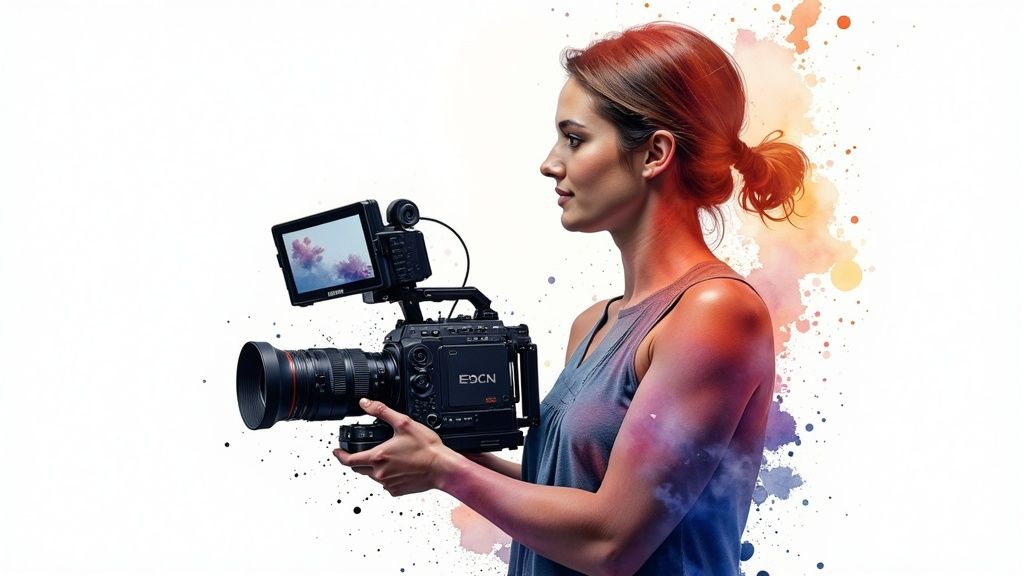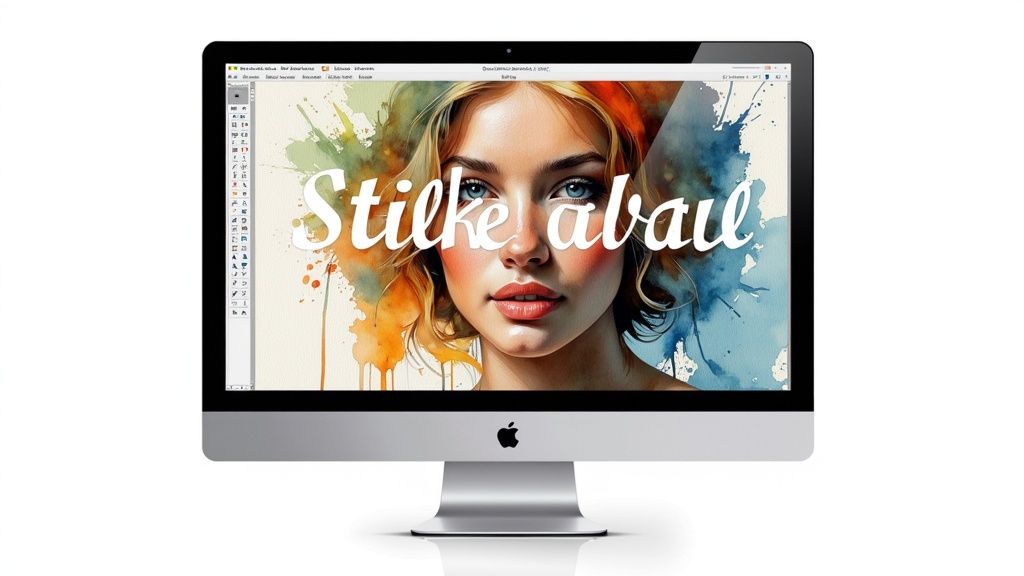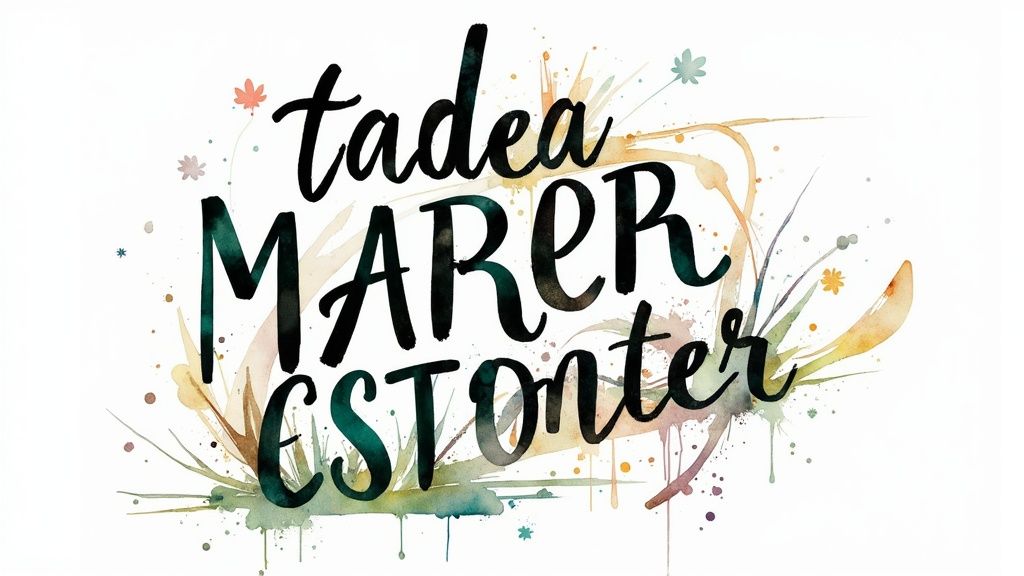Understanding the Psychology of Text Overlays

Adding text to video requires more than just technical skills - it's about creating a deeper connection with your viewers. When done well, text overlays can help guide attention, reinforce key messages, and make your content more memorable by tapping into how people naturally process visual information.
The Power of Visual Hierarchy
Our brains automatically organize what we see based on visual hierarchy. By thoughtfully positioning text overlays, you can direct viewers' focus to what matters most. Using larger, bolder text for main points and smaller text for details creates a natural flow that helps people absorb information without feeling overwhelmed.
Timing is Everything
The timing of text overlays can make or break viewer engagement. Just like a perfectly timed pause builds suspense in movies, text that appears at the right moment enhances understanding and keeps viewers hooked. However, text that lingers too long or appears too early can disrupt the viewing experience. For best results on social media, keep text slides brief (4-5 seconds max) and split longer messages across multiple slides. Learn more about text overlay best practices.
Emotional Resonance Through Design
The design of your text overlays shapes how viewers feel about your content. Your choice of fonts, colors, and animations sets the mood - playful fonts and bright colors work well for fun content, while clean fonts and subtle colors suit professional pieces. These design elements subtly influence how people connect with your message. For more design tips, check out our complete guide to text overlays.
Balancing Impact and Clarity
The main goal is to improve communication while keeping viewers engaged. This means finding the sweet spot between eye-catching design and readability. While creative animations can grab attention, they shouldn't overshadow your message. Similarly, too much text becomes hard to read quickly. The key is making text overlays both visually appealing and easy to understand by carefully considering visual hierarchy, timing, and design elements.
Mastering Text Animation and Style Selection

Adding text to video is a core skill in visual storytelling. The right text animation and style choices can make your message more compelling and memorable. Smart text design helps viewers connect with and retain your content.
The Art of Text Animation
Each animation style serves a specific purpose. Fade-ins work well for introducing information smoothly, while bouncy animations grab attention for calls-to-action. You can match animations to your message - gentle zooms highlight product details, while quick slide-ins create excitement and urgency.
Choosing the Right Style for Your Message
Your text style should match both your video's look and your target viewers. For younger audiences, try playful handwritten fonts and bright colors. Corporate presentations need clean, professional fonts with subtle motion. Really understanding who you're creating for helps you pick text styles that resonate.
Avoiding Common Pitfalls
Too many animations or mismatched styles can distract from your message. When text moves too much or too fast, it becomes hard to read. Poor animation timing can create a disconnect between your visuals and text. Make sure viewers have enough time to read and process text before it disappears.
When working with text overlays, consider using different styles like plain text, subtitles, typewriter effects, or bouncing text to enhance your video. Tools like Clipchamp make it easy to add and customize text, including scrolling credits, star ratings, and quote overlays.
Creating a Consistent Visual Language
Build a clear set of text styles that reflect your brand. Pick specific fonts, colors, and animations and use them consistently. This makes your videos instantly recognizable and helps build trust with viewers over time.
Best Practices for Superimposing Text
Here are key tips for adding text to your videos:
- Less is More: Keep text minimal and focused on key messages
- Contrast is Key: Make sure text stands out clearly against the background
- Strategic Placement: Position text where it won't block important visuals
- Timing is Everything: Sync text with spoken words and on-screen action
- Test and Refine: Try different styles to find what works for your content
Following these guidelines helps create text overlays that both inform and engage your audience. Well-designed text can transform basic videos into compelling stories that viewers remember.
Selecting and Maximizing Professional Tools
Picking the right tools for adding text to video makes a big difference in how smoothly and effectively you can create content. The options range from simple mobile apps to advanced professional software, each with distinct capabilities. Understanding what each tool offers helps you pick one that fits your needs and budget.
Types of Video Tools
There are two main categories of video editing tools: basic and professional. Basic tools, which are often free or low-cost, give you essential text overlay features - perfect for simple social media videos. Professional tools include advanced options like animation, keyframing, and detailed text styling for more complex commercial projects.
The video editing software market keeps growing as more people create video content. The market size reached $1.97 billion in 2021, and experts predict it will grow 5.9% each year until 2030. Learn more from this Video Editing Software Market Research.
What to Look For in a Tool
When choosing software to add text to videos, check for these key features:
- Text Options: Good font selection, size controls, color choices, and formatting tools
- Animation Tools: Ways to make text move, including transitions and special effects
- Software Integration: How well it works with other programs you use
- User-Friendly: Easy to learn and use, especially for beginners
- System Support: Works on your computer (Windows, Mac, Linux) and saves in formats you need
Creating an Effective Process
Smart video creators often use multiple tools together. They might use one program for the main video editing and another for special text effects. This approach lets them get the best results from each tool. Check out our guide on How to Create Video Content for Social Media: A Proven Success Framework.
Getting the Most from Your Tools
Even simple software can produce great results if you know how to use it well. Take time to watch tutorials and read guides to find helpful shortcuts and hidden features. Learning keyboard commands, saving presets, and using automation can speed up your text overlay work significantly.
Popular Tool Examples
| Tool Category | Software Examples | Key Features |
|---|---|---|
| Basic | Kapwing, Canva, Clipchamp | Simple interface, basic text and animation, great for beginners |
| Professional | Adobe Premiere Pro, Final Cut Pro, DaVinci Resolve | Advanced text control, strong animation options, professional features |
Choose your tools carefully and learn them well to create engaging videos with text overlays that grab attention. Try different combinations of tools to find what works best for your style and projects.
Creating Dynamic Data Visualizations

Adding text overlays to video is more than just basic captioning - it's an opportunity to turn raw data into compelling visual stories. When you combine text, data, and motion graphics effectively, you can create videos that both inform and engage your viewers on a deeper level.
Telling Stories Through Data
Raw numbers alone rarely capture attention. That's where data visualization makes the difference - by transforming statistics into clear visual elements like charts and graphs, you create narratives that stick with viewers.
Consider a company's five-year growth story: A simple list of revenue numbers feels flat, but an animated line graph showing steady upward progress immediately communicates success. The visual approach makes complex information easy to grasp at a glance.
Video content featuring data and stats can be incredibly effective when done right. By combining animated text, graphics and audio thoughtfully, you can present large amounts of information in an engaging way. Learn more about making stats videos engaging in this guide from Motion Edits.
Picking the Perfect Visual Format
Different types of data need different visual treatments. Pie charts work well for showing parts of a whole, while bar graphs excel at comparing categories. Line graphs display trends across time, and scatter plots reveal relationships between variables.
For more complex datasets, simple charts may not be enough. Advanced visualizations like heat maps or tree maps might better serve your story. This is where tools like Aeon can help streamline the visualization process.
Bringing Data to Life with Animation
While static visualizations work, animation adds an extra layer of engagement. Picture a bar graph where each bar rises dramatically to its final height, or a line graph that traces its path across time. These motion elements naturally draw the viewer's eye and make key points more memorable.
Animation also lets you reveal information gradually, building anticipation and keeping viewers focused. This approach works especially well when explaining complex concepts or walking through a data-driven story.
Creating Visualizations Easily with Aeon
Making professional data visualizations may seem complicated, but Aeon makes it straightforward. The platform's AI capabilities help you quickly generate charts and graphs from your data. You can customize colors and styles to match your brand, and add smooth animations all within Aeon.
This built-in visualization toolkit saves significant time and effort, letting you focus on crafting your message. The seamless integration of data graphics with video editing makes Aeon especially useful for anyone looking to enhance their videos with clear, engaging data stories.
AI for Better Text in Video Content
AI is opening up new possibilities for adding text to videos. From automatically placing captions to suggesting optimal text styles, AI tools are making text integration faster and more effective. Content creators can now focus more on their creative vision while AI handles the technical aspects.
Smart Text Placement and Design
Automated text placement is one of the key AI advancements in video creation. AI can analyze video content to identify the best spots for text overlays, ensuring text is readable and visually balanced. The technology also helps with style selection, recommending fonts, colors, and animations that match the video's mood. For instance, AI might suggest bold fonts for action scenes or elegant typography for dramatic moments.
Making Captioning Simple
AI is also revolutionizing video captioning. Modern AI tools can convert speech to text with high accuracy and generate captions in multiple languages, helping videos reach wider audiences. This capability is especially valuable for creators working internationally or focusing on SEO. Learn more: AI Captions for Video: Boost Accessibility, Engagement, and SEO.
Text-to-Video AI Market Growth
The text-to-video AI sector is seeing major growth as demand rises for dynamic video content. The market size reached $0.16 billion in 2024 and is expected to hit $1.40 billion by 2031, showing a strong 36% CAGR. For more details, see: Text-to-Video AI Market Research.
Combining AI Tools with Creative Vision
While AI brings speed and efficiency, the human creative element remains crucial. AI works best as a creative assistant, handling technical tasks while humans make key decisions about storytelling and emotional impact. The most compelling videos come from blending AI capabilities with human artistic judgment.
Aeon: Smart Video Creation for Publishers
Aeon helps publishers create professional videos efficiently using integrated AI tools. The platform simplifies text overlays with features like automated placement, style recommendations, and AI captioning. This allows publishers to produce engaging videos while maintaining consistent branding, all with minimal manual work. Aeon gives publishers the tools they need to create compelling content that connects with their audience.
Essential Best Practices and Professional Solutions

Adding text to video requires careful planning and execution to create a polished final product. The text should complement the video content while being easy to read and visually appealing. Here are key guidelines that professionals use to create high-quality text overlays that keep viewers engaged.
Font Selection and Readability
Pick fonts that match your brand style and video mood. A casual script font works well for fun content, while clean sans-serif fonts suit business videos. Make sure there's enough contrast between text and background - light text on dark backgrounds or dark text on light backgrounds tends to work best.
Color Contrast and Branding
Smart color choices help grab attention and build brand recognition. Use your brand colors consistently but avoid overly bright or clashing combinations that distract from the content. Stick to a defined color palette across all your videos to help viewers instantly recognize your content.
Timing and Synchronization
Text needs to appear at just the right moment and stay on screen long enough to read comfortably. Match text timing with the audio and visuals to emphasize key points. For example, display product names when they're mentioned by the speaker to reinforce the message.
Placement and Composition
Plan text placement carefully to avoid covering important video elements. Position text thoughtfully within the frame to support the visual story. Keep text within the "safe title area" - slightly inset from screen edges - so it displays properly on all devices.
Quality Control and Review
Always review videos thoroughly before publishing. Check spelling, wording, and timing on different devices to ensure everything looks right. A final quality check helps catch any issues before your audience sees the content.
Practical Checklists for Text Overlay Success
Follow these checklists to create professional text overlays:
-
Readability:
- High contrast between text and background
- Easy-to-read font size
- Simple, clear wording
-
Timing:
- Enough time to read comfortably
- Text matches audio/visual elements
- No overlapping text elements
-
Placement:
- Text doesn't block key visuals
- Text stays in safe title area
- Consistent positioning throughout
Following these guidelines helps create compelling videos with text overlays that connect with viewers effectively.
Want to make professional videos with dynamic text overlays? Aeon helps publishers create engaging video content from text, audio and video assets. See how Aeon can improve your video production.